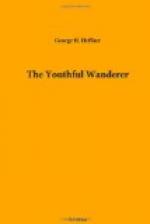At Worms my attention had already been arrested by social phases that reminded me of America, but at Frankenthal I met an officer at the station, who, upon being asked where the peculiar Palatinate dialect was spoken, not only mentioned to me the places, but also gave me a list of Pfaelzish words that are peculiar to them, most of which are purely Pennsylvania German both in their pronunciation and their meanings. A young girl at the hotel and her brother not only used language similar to ours, but betrayed their kinship in various other ways. I spent about a week in Mannheim, Neustadt, Speyer and the surrounding country, during which time I devoted all my attention to the question of our common ancestry. That those people are cousins to many of our Pennsylvania Germans can easily be proved in a variety of ways, even when we throw aside the traditional and historic evidences which we have that many Pennsylvanians have emigrated from the Pfalz in times past. The most convincing proof to those who can not go there and see the people themselves, likely consists in the fact that many of the family names of the Pfaelzer and of our Pennsylvania Germans are the same. I attended the large annual Saengerfest at Neustadt, in which 973 singers from all parts of the Pfalz participated. I procured a catalogue of their names and found that a very large proportion are the same as those of the majority of our people. When we contrast with this the fact that the proportion of names common between our people and that of any other section, is much smaller, we see the force of the argument. But this is by no means the first thing that strikes the visitor. Consanguinity or relationship by blood betrays itself in a hundred ways. Particular words and expressions, peculiar pitches of the voice, styles of address, forms of salutations, and special ways of performing certain kinds of work, tell their tale with an emphasis that makes itself understood even to the unscientific observer. The expression of the face and the very ring of the laugh often impressed me with the truth that it was that of a cousin’s brother or sister. I often expressed my surprise at these things to those around me, and by a free indulgence in the peculiarities of their idiom enlisted the attention and gained the friendship of those people with magical effect. From Frankenthal I went to
Mannheim,
which is the most regularly built town in Germany. It is divided into 100 squares like a chess-board, and has about 40,000 inhabitants. It consists of 20 sections lettered from A to U (the J being excluded from the nomenclature) and the squares of each sections numbered from 1 to 5. As the city enlarges in territory the numbers of the squares run from 5 upwards. The streets are named as in other cities, but the houses are numbered around the squares. Thus the Mannheimer Familienblatter (a newspaper published in the Pfaelzisch dialect, which is like the Pennsylvania German) is printed at E 1. 8.—Section E, Square 1, No. 8.




